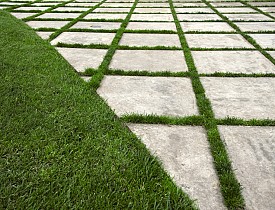Building Green with Concrete
 Concrete is perhaps the most common construction material in the world. The US Geological Survey calculated global cement production at more than two billion metric tons per year, and a majority of that cement is used in concrete.
Concrete is perhaps the most common construction material in the world. The US Geological Survey calculated global cement production at more than two billion metric tons per year, and a majority of that cement is used in concrete.
Most concrete production is not inherently eco-friendly. Environmental Building News magazine notes that the annual US carbon dioxide output from cement production equals the carbon dioxide emissions from 22 million cars. Some of the chemical binders and additives used in concrete are also environmentally hazardous.
However, concrete is a great insulator, and it can be produced in a variety of more sustainable ways. There are also many construction options that cut the amount of concrete needed for a project. Here are some specific ways to make the production and use of concrete more sustainable and environmentally sound.
Greener Concrete
Find concrete made with fly ash cement. Fly ash is a waste byproduct of coal-fired power production. It can be recycled to form up to half of the cement in standard concrete. Some experts say fly ash concrete is stronger and more durable, further reducing its environmental impact by saving replacement energy, costs and resources. Companies are also starting to incorporate other waste products into concrete, including rice hulls.
Using Less Concrete
Even with recycled content, concrete production still requires resources and energy. To minimize the amount of resources used in construction, you should find ways to use less concrete for equally solid construction.
Autoclaved cellular concrete is a type of preformed concrete block with aerated concrete. It is lighter than traditional concrete, yet it's just as strong and offers better insulation. Insulated concrete forms are another option. They are light foam blocks that hold poured concrete, then remain in the walls and foundation, reducing the amount of concrete required and, again, improving insulation.
You also can save concrete in construction by excavating a shallower foundation or using lightweight pre-cast concrete. Consult local building codes, but in most areas, a 16-inch foundation is adequate. Such a foundation can also be more energy efficient by making better use of natural subsurface insulation.
Keeping it Natural
Concrete subfloors can serve as the real floor. Concrete can be textured or colored for a unique and beautiful surface. Leaving concrete bare avoids all the resource usage and environmental impacts of wood, carpet or other flooring. It also lasts longer than carpet or tile.
Of course, skipping one layer of flooring also saves money, and may be healthier for your family. Concrete is easy to clean, has minimal volatile organic compounds, and it doesn't attract mold and other pollutants to your indoor environment.
It can also reduce energy costs. Because of the insulating properties of concrete, it is an ideal medium for radiant heat flooring, as well as passive solar heat gain.
These are some concrete examples of how to compensate for the potentially high environmental impact of concrete in construction. Be sure to seek out concrete with recycled content, minimize materials usage and take advantage of concrete floors.
Photo credit: John Brooks Photography
Looking for a Pro? Call us (866) 441-6648

Concrete Average Costs
Concrete Contractors Experiences

Yard Cleanup And Lawn Care Service With A Great Work Ethic

Careful, Professional Tree Service Removes A Huge Norway Maple



